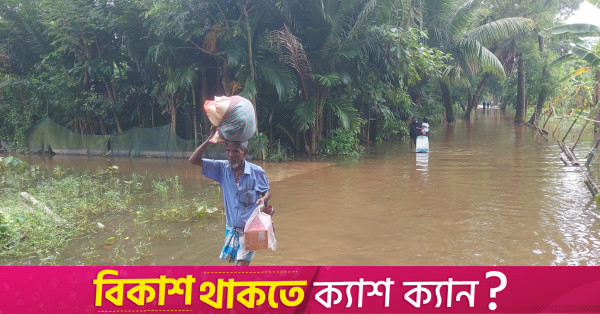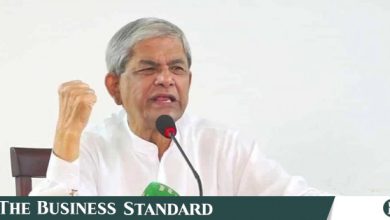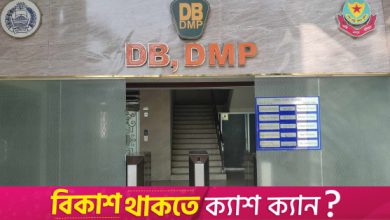Floodwaters stuck in Lakshmipur: What’s really to blame?


The floodwaters in Feni appear to come to a halt in neighbouring Lakshmipur, a downstream district through which waters were supposed to recede into the Bay of Bengal in a few days.
For nearly two weeks, vast tracts of areas across the district have been submerged in water. Lakshmipur Sadar upazila looks like a vast water body, while Ramganj and Raipur are overflowing with floodwaters.
In Ramgati and Kamalnagar, five unions have remained submerged for nearly one and a half months, with no sign of the water receding. Locals are terming the flooding and waterlogging of the region unprecedented.
To understand why the floodwaters have come to a standstill in Lakshmipur, despite being a downstream district that should see the receding waters flow towards the Bay of Bengal, The Business Standard has conducted an in-depth investigation.
Over the past few days, this correspondent has spoken with around 50 people from various upazilas to gather their first-hand experiences.
Climate expert and journalist Rafiqul Islam Montu fully agrees with the experiences of the residents. “The coastal regions, surrounded by rivers and canals, serve as the only drainage route for the country’s water to flow out. Cyclones occasionally strike the coast, and high tides sometimes flood the area for a few hours. However, within 5-6 hours, or a little longer, that water typically recedes,” he said.
Montu explained that the sole reason for this prolonged flooding is land grabbing and obstruction of water bodies in the region.
Water trapped by embankments, fish enclosures
In areas near the Meghna River, the river’s water level is 8-10 feet below the embankments. Many agricultural fields along the Meghna banks are dry, with no water in sight. However, just a little farther away, the situation is completely different, with water everywhere, creating a stark contrast.
The Bhulua River, flowing from the Meghna River through Ramgati, Kamalnagar, Lakshmipur sadar, and Noakhali’s Subarnachar and sadar upazilas, converges at the Wapda canal in Lakshmipur sadar. Another branch of the river flows further into Noakhali. Along this 76-kilometre stretch of the river, every few stretches are obstructed by either a fishing net, a submerged embankment, a residential pathway, or a road leading to a brick kiln.
Various types of nets and embankments have trapped the water, making it impossible to move. In the Kodak Bazar to Azadnagar area of Charporagacha union in Ramgati, some land grabbers have occupied sections of the Bhulua River and sold it to settlers.
These settlers have established fish enclosures and poultry farms in the river. The once 500-metre-wide Bhulua River has been reduced to just 30 feet in width at a point. As a result, water from 76 kilometres upstream is unable to drain through the shallow 30-foot channel.
On the eastern side of the Lakshmipur-Ramgati road, from Bhabaniganj to Torabganj Bazar, Musha Canal connects Wapda Canal at one end and the Meghna River at the other. The canal, which is around 100 feet wide, has been completely blocked in the Char Monsa area by large roads built by nearby brick kilns.
The small river Dakatia flows from Cumilla, winding through Chandpur and Noakhali before reaching Lakshmipur. Residents Azam Khan and Abdur Rahman Sumon said the river has been blocked by hundreds of submerged and visible embankments near Raipur Bazar.
Raipur Government Women’s College was even built on the riverbed of Dakatia. Influential locals have divided the river among themselves, using large nets and water hyacinth barriers to cultivate fish.
Garbage blocking canals
The only canal that directs water flow from Chandpur’s Hajiganj and Noakhali’s Sonaimuri to the western Dakatia River is the Birendra Canal. Flowing through Ramganj upazila town, the canal has become clogged with hundreds of tonnes of garbage, preventing water from Sonaimuri from reaching the Dakatia River.
Mandari is a large market located on the Lakshmipur-Choumuhani road. To the east of the market, the Mandari-Mollarhat Canal connects to the Rahmatkhali Canal. Within 500 metres of the market, there is not an inch of space left in the canal, which is completely filled with garbage, blocking the flow of water entirely.
Along the Lakshmipur-Choumuhani road, the markets beside the Rahmatkhali Canal have all contributed hundreds of tonnes of waste to the canals, filling them up.
According to the Local Government Department office of the district, there are 179 licensed markets throughout Lakshmipur. In addition, there are over a hundred smaller markets. Most of the waste generated from these village markets is discarded into nearby canals.
Sluice gates occupied
Locals have taken over the sluice gate on the Ratachura Canal, a branch of the Bhulua River, and established a market there. As a result, four out of six gates have been shut.
Similarly, markets have been set up by locals at the sluice gates of the Maulavi Bazar, Chowdhuribazar, and Torabganj East markets, blocking these gates.
According to the Lakshmipur Water Development Board, there are 8 regulators and 23 sluice gates across various canals in Lakshmipur. Nearly all of them have been occupied, locals said.
What officials say
Executive Engineer Mohammad Nahiduzzaman of the Lakshmipur Water Development Board told TBS that besides the three main rivers in Lakshmipur, there are 99 small and large canals and their branches, with a total length of 498 kilometres.
Mohammad Ikramul Haque, executive engineer of the Local Government Engineering Department in Lakshmipur, told TBS that nearly all the canals in Lakshmipur have been occupied in various ways.
In the past fiscal year, only three canals in Lakshmipur were scheduled for renovation, covering approximately 7 kilometres, he said.
“However, the renovation process faced significant challenges due to issues such as encroachment by influential individuals, boundary disputes involving the Forest Department’s trees, and difficulties in determining canal boundaries,” Haque said.
Abdullah Al Mamun, assistant engineer of the Lakshmipur Irrigation Division at the Bangladesh Agricultural Development Corporation, told TBS that from 2018 to 2024, they took care of 140 kilometres of various canals in Lakshmipur.




